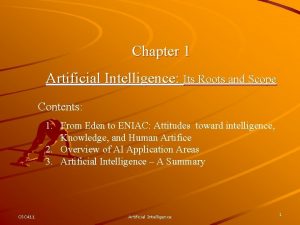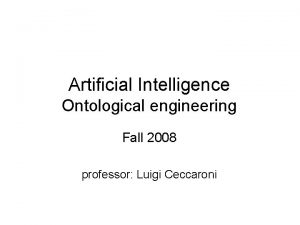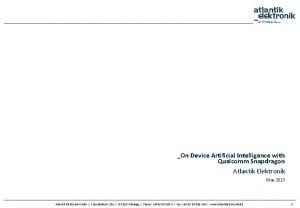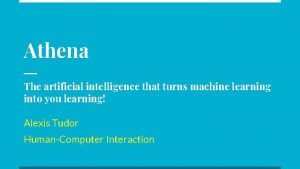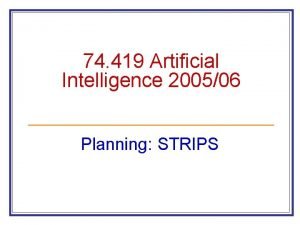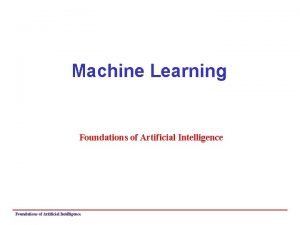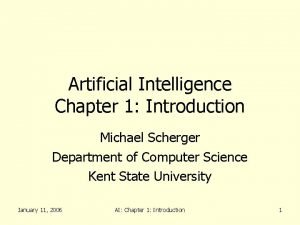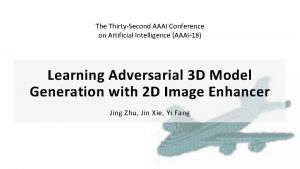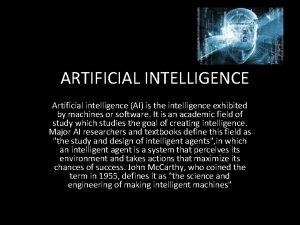The ThirtyThird AAAI Conference on Artificial Intelligence Honolulu
















- Slides: 16

The Thirty-Third AAAI Conference on Artificial Intelligence Honolulu, Hawaii, USA. January 27–February 1, 2019 SVM-based Deep Stacking Networks Jingyuan Wang, Kai Feng and Junjie Wu Beihang University, Beijing, China

Motivation: How to build a deep network? • Neural Network • Proved to be powerful in numerous tasks • Based on other models • The alternative to neural network is worth trying • For example: image classification, • For example: PCANet (Chan et al. machine translation, trajectory 2015), gc. Forest (Zhi-Hua Zhou 2017), prediction etc. Deep Fisher Networks (Simonyan, Vedaldi, and Zisserman 2013) An illustration of the gc. Forest (Zhi-Hua Zhou 2017)

Related Works • Stacking ensemble • Introduced by Wolpert (Wolpert 1992) • Used in many real-world applications; • Used to integrate strong base-learners (Jahrer et al. 2010) • Researches focused on designing elegant meta-learners (Ting and Witten 1999; Rooney and Patterson 2007; Chen et al. 2014) • Limitation: • Very few works studied how to optimize multi-layer stacked baselearners as a whole. • Performance of the ensemble depends on the diversity of base-learners, which is hard to measure (Sun and Zhou 2018). • Deep Stacking Network frame • Adopted in various applications (Deng et al. 2013; Li et al. 2015; Deng and Yu 2011) • Structure is flexible, thus has mulitple variants (Hutchinson et al 2013; Zhang et al. 2016) • Base blocks could be trained in a parallel way (Deng et al. 2013; Deng and Yu 2011) • Limitation: • Mainly based on neural networks, may be unsatisfactory on interpretability. • Why not use other sorts of base learns, since one layer ANN is not the best shallow learner.

Support Vector Machine

SVM-DSN Block … … … SVM 1 SVM 2 … …

Stacking Blocks SVM Blocks are stacked according to Deep Stacking Network. SVM An illustration of the DSN architecture (Deng, He and Gao 2013)

Block Training • The objective function • Efron bootstrap (Efron and Tibshirani 1994) to increase the diversity of base-SVMs.

Fine Tuning • BLT: BP-like layered Tuning • Virtual label

Objective function in fine tuning • SVM&SVR: virtual labels are not guaranteed to be in {-1, 1}. It is still a convex optimization problem. • Recursively calculate the partial derivative.

Model Properties • An illustration of the Parallel Support Vector Machines (Graf et al 2005)

Model Properties • Anti-saturation: the partial derivative for a neuron. For common activation function like sigmoid and Re. LU, can be 0 or near 0 even if there is still much room for the optimization of .

Model Properties • Interpretation: average confidence The change of “classifying plane” maps illustrate the feature extract process.

Experiments •

Experiments • Result on MINST • The general scenario ―stacking method in (Perlich and Swirszcz 2011) is used.

Conclusions • In this paper, we rethink the build of deep network, and present a novel model SVM-DSN. • It can take the advantage of both SVM and DSN: the good mathematical property from SVM and flexible structure from DSN. • As showed in our paper, SVM-DSN has many advantageous properties including optimization and anti-saturation. • The results showed that SVM-DSN is a competitive compare with tradition methods in various scenarios.

THANK YOU! Email: fengkai@buaa. edu. cn Webpage: http: //www. bigscity. com/
 Aaai
Aaai Andrew yang vpn
Andrew yang vpn Here's honolulu hawaii's a joy
Here's honolulu hawaii's a joy Honolulu cookie company whalers village
Honolulu cookie company whalers village Fuzzy propositions in artificial intelligence
Fuzzy propositions in artificial intelligence Artificial intelligence chapter 1
Artificial intelligence chapter 1 Ontological engineering in artificial intelligence
Ontological engineering in artificial intelligence Atlantik networxx
Atlantik networxx Agent in artificial intelligence
Agent in artificial intelligence Athena artificial intelligence
Athena artificial intelligence Strips planning example
Strips planning example What is declarative knowledge in ai
What is declarative knowledge in ai Learning in ai
Learning in ai Artificial intelligence thesis proposals
Artificial intelligence thesis proposals References for artificial intelligence
References for artificial intelligence What is artificial intelligence class 6
What is artificial intelligence class 6 Artificial intelligence chapter 1
Artificial intelligence chapter 1





